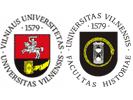The investigations in the Poland-Lithuania union were carried out first in Polish and Russian historiography and latter in the Lithuanian one. During the 30–40’s the latter studies dealt with the earliest before-union Lithuanian history and amphasized the independent, long-lasting monarchy and the Lithuanian statehood inside the union. Signing the Krėva treaty in 1385 Jogaila did not think about incorporating Lithuania into Poland but intended to rule both states by himself. Thus, in 1385 only a personal inter-state relationship was stated (A. Šapoka). After restoration of an independent Lithuanian ruler dynasty in 1392, Jogaila possessed no power in Lithuania and did not issue any documents (K. Jablonskis). The rule of Jogaila and his heirs in Lithuania was interrupted. Such a situation remained unchangen until the Lublin union which did not abolish the Lithuanian state but constituted the union of two states (A. Šapoka, K. Avižonis, B. Dundulis). However, after the Lublin union Lithuania was left “with limited statehood” (J. Jakštas). The 17th and 18th centuries were the centuries of rapprochement rather than merging of two states and two political nations (A. Šapoka). During the Sowiet times Lithuanian historiography, influenced by Russian historians works, evaluated the Lublin union negatively describing it as burying of Lithuanian state, intensification of noble privileges and obstance of social progress (J. Jurginis).
Russian historiography appropriated the Lithuanian state and called the Grand Duchy of Lithuania as the West Russian state, the continuation of Kiev state in the territory of Western Russian. According to this historiography the biggest part of territory and population belonged to the Russian ethnos. Its early christianization and, consequently, written language and spiritual culture gave the priority to the Eastern part of that state. The political life, under the conditions of full decentralization, was determined by the federation of regions (mainly Russian ones). The disputes concerned only the nature of ethnos: wherther it was Russian or Byelorussian during the 15th and 16th centuries.
The Russian historiography was unanimous about the Lublin union which interrupted a natural development of the Lithuanian state and subordinated Lithuania to the political, cultural and religious interests of Poland. Liberation came only in 1795 when the Grand Duchy of Lithuania was incorporated into the Russian empire.
The parliamentary union was treated from the point of view of Russian researchers who investigated the early state of Lithuania. M. Lubavski studied the diet of the Grand Duchy of Lithuania until 1569. He treated the parliamentary history of the 15th and 16th centuries as a growth of political consciousness of noblemen and, consequently, their search for greater political rights together with Polish szhlachta. So, the real union came in 1569. V. Pičeta dealt with the economical and social system. Thus, he stated that the real union was determined by the estates privileges and the Lithuanian noblemen strive for consolidation and increase of these privileges following the Polish szclachta. Whereas, J. Lappo was interested in the Russian ethnos and his estimation of the union was based on it.
German historians considered that the Lithuanian state was formed in the ethnic Lithuanian territory and the Russian annexation came later. But Lithuania showed religious tolerance in the Russian territories and provided them with a wide selfgovernment (H. Jablonovski). German historians agreed that the union created a twostate Poland–Lithuania state – Doppelreich (J. Pfitzner, G. Rhode, M. Bockmann, S. Ekdahl). Some of them (G. Rhode, H. Gersdorf) thougtht that the union was initiated by Poles and it was not directed against the German Order which Poland had no conflict with since 1343. In 1385 the Poles represented the interests of “Poloniae Minoris”. It was only M. Hellmann who thought that the union was in one way or another directed against the German Order. He emphasized the significance of the union for the whole Central Europe. K. Forstreuter pointed out the late christianization of Lithuania and its importance. Thus, the union was more important in cultural rather than in political respect. Poland was more wise in solving this problem than the German Order which approved only armed force against pagans (Heidenkampt). Lithuania remained in that noble Republic (Adelsrepublik) only because it was under the Russian cultural influence and regained its cultural peculliarities (K. Zernack). However, during the 17th and 18th centuries Lithuania remained in the shadow of Poland and had a limited self-gpvernment (M. Hellman, K. Zernack). |


 dizainas ir programavimas giriaus
dizainas ir programavimas giriaus  dizainas ir programavimas giriaus
dizainas ir programavimas giriaus